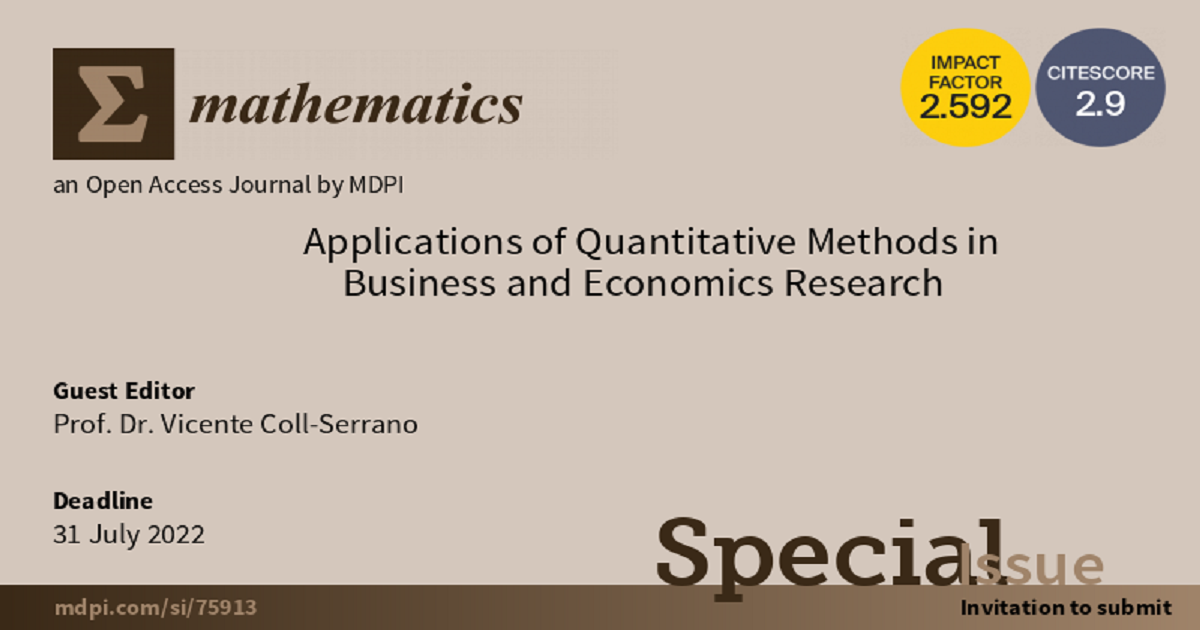Applications of Quantitative Methods in Business and Economics Research
A special issue of Mathematics (ISSN 2227-7390). This special issue belongs to the section "E5: Financial Mathematics".
Deadline for manuscript submissions: closed (31 July 2022) | Viewed by 78752

Special Issue Editor
Special Issue Information
Dear colleges,
Data we traditionally use in our empirical research comes from sources such as surveys, polls, questionnaires, databases, etc. However, the development of information and communication technologies and the increasing connection of things with the Internet generate an amazingly huge amount of both structured and unstructured data every minute. But the data does not say anything by itself, it does not add value. Raw data needs to be processed, treated, and analyzed using mathematical, statistical, econometric, and/or computational methods to extract the real value, knowledge. This will allow researchers and professionals to obtain substantial improvements in the processes they are engaged in. In summary, the use of quantitative methods in economics and business research helps to understand the socio-economic and business systems, either by creating new models or improving existing ones. In this sense, for example, prediction models (based on conventional or new techniques) can be used to support decision-making processes and improve the results of companies and institutions.
This Special Issue publishes original research articles that apply quantitative methods in fields such as economics, management, marketing, banking and finance, actuarial, accounting, cultural and creative industries, tourism, operations research, and so on. Research articles describing new R software packages that implement novel quantitative techniques are also welcome.
Only high-quality manuscripts that represent real progress in knowledge within their field will be accepted.
Prof. Dr. Vicente Coll-Serrano
Guest Editor
Manuscript Submission Information
Manuscripts should be submitted online at www.mdpi.com by registering and logging in to this website. Once you are registered, click here to go to the submission form. Manuscripts can be submitted until the deadline. All submissions that pass pre-check are peer-reviewed. Accepted papers will be published continuously in the journal (as soon as accepted) and will be listed together on the special issue website. Research articles, review articles as well as short communications are invited. For planned papers, a title and short abstract (about 100 words) can be sent to the Editorial Office for announcement on this website.
Submitted manuscripts should not have been published previously, nor be under consideration for publication elsewhere (except conference proceedings papers). All manuscripts are thoroughly refereed through a single-blind peer-review process. A guide for authors and other relevant information for submission of manuscripts is available on the Instructions for Authors page. Mathematics is an international peer-reviewed open access semimonthly journal published by MDPI.
Please visit the Instructions for Authors page before submitting a manuscript. The Article Processing Charge (APC) for publication in this open access journal is 2600 CHF (Swiss Francs). Submitted papers should be well formatted and use good English. Authors may use MDPI's English editing service prior to publication or during author revisions.
Keywords
- Big data
- Boosting
- Causal and predictive modeling
- Data envelopment analysis
- Data mining
- Deep learning
- Dynamic factor models
- Multicriteria decision making
- Multivariate analysis
- Neuronal network
- R programming
- Random forest
- Recommendation Systems
- Sentiment analysis
- Statistical learning
- Structural equation models
- Support vector machine
- Wavelet analysis
Benefits of Publishing in a Special Issue
- Ease of navigation: Grouping papers by topic helps scholars navigate broad scope journals more efficiently.
- Greater discoverability: Special Issues support the reach and impact of scientific research. Articles in Special Issues are more discoverable and cited more frequently.
- Expansion of research network: Special Issues facilitate connections among authors, fostering scientific collaborations.
- External promotion: Articles in Special Issues are often promoted through the journal's social media, increasing their visibility.
- e-Book format: Special Issues with more than 10 articles can be published as dedicated e-books, ensuring wide and rapid dissemination.
Further information on MDPI's Special Issue polices can be found here.





